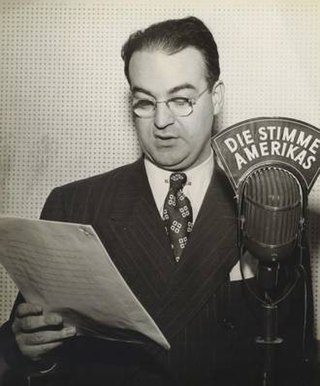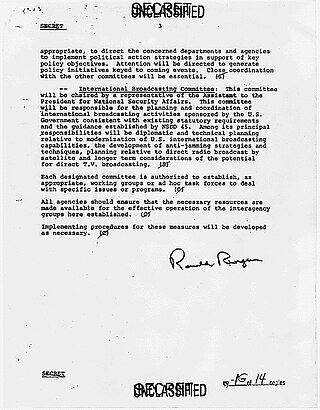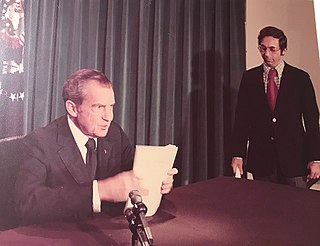
Voice of America is the state-owned news network and international radio broadcaster of the United States of America. It is the largest and oldest of the U.S.-funded international broadcasters. VOA produces digital, TV, and radio content in 49 languages, which it distributes to affiliate stations around the world. Its targeted and primary audience is non-American. As of November 2022, its reporting reached 326 million adults per week across all platforms.

Radio Free Europe/Radio Liberty (RFE/RL) is an American government-funded international media organization that broadcasts and reports news, information, and analyses to Eastern Europe, Central Asia, the Caucasus, and the Middle East, where it states that "the free flow of information is either banned by government authorities or not fully developed." RFE/RL is a private 501(c)(3) corporation and is supervised by the U.S. Agency for Global Media, an independent government agency overseeing all international broadcasting services that receive American government support. Jeremy Bransten is the organization's acting editor-in-chief.
In international relations, public diplomacy broadly speaking, is any of the various government-sponsored efforts aimed at communicating directly with foreign publics to establish a dialogue designed to inform and influence with the aim of building support for the state's strategic objectives. These also include propaganda. As the international order has changed over the twentieth century, so has the practice of public diplomacy. Its practitioners use a variety of instruments and methods ranging from personal contact and media interviews to the Internet and educational exchanges.

Cultural diplomacy is a type of public diplomacy and soft power that includes the "exchange of ideas, information, art, language and other aspects of culture among nations and their peoples in order to foster mutual understanding". The purpose of cultural diplomacy is for the people of a foreign nation to develop an understanding of the nation's ideals and institutions in an effort to build broad support for economic and political objectives. In essence "cultural diplomacy reveals the soul of a nation", which in turn creates influence. Public diplomacy has played an important role in advancing national security objectives.

The U.S. Information and Educational Exchange Act of 1948, popularly called the Smith–Mundt Act, was first introduced by Congressman Karl E. Mundt (R-SD) in January 1945 in the 79th Congress. It was subsequently passed by the 80th Congress and signed into law by President Harry S. Truman on January 27, 1948.

In the United States, propaganda is spread by both government and non-government entities. Throughout its history, to the present day, the United States government has issued various forms of propaganda to both domestic and international audiences. The US government has instituted various domestic propaganda bans throughout its history, however, some commentators question the extent to which these bans are respected.

Psychological operations (PSYOP) are operations to convey selected information and indicators to audiences to influence their motives and objective reasoning, and ultimately the behavior of governments, organizations, groups, and large foreign powers.

The Bureau of Educational and Cultural Affairs (ECA) of the United States Department of State fosters mutual understanding between the people of the United States and the people of other countries around the world. It is responsible for the United States' cultural exchange programs.

The U.S. Department of State's Bureau of International Information Programs (IIP) supported the department's public diplomacy efforts by providing and supporting the places, content, and infrastructure needed for "sustained conversations" with foreign audiences. It was headed by the Coordinator for International Information Programs. IIP was one of three bureaus that reported to the Undersecretary for Public Diplomacy and Public Affairs. The Bureau of Educational and Cultural Affairs and the Bureau of Public Affairs were its sister bureaus. On May 28, 2019, IIP merged with the Bureau of Public Affairs into the Bureau of Global Public Affairs, and the duties of IIP Coordinator merged into the duties of the Assistant Secretary of State for Global Public Affairs.
The Psychological Strategy Board (PSB) was a committee of the United States executive formed to coordinate and plan for psychological operations. It was formed on April 4, 1951, during the Truman administration. The board was composed of the Under Secretary of State, the Deputy Secretary of Defense, and the Director of Central Intelligence, or their designated representatives. The board's first director was Gordon Gray, later National Security Advisor during the Eisenhower administration. The board was created in response to the growth of Office of Policy Coordination covert activities during the Korean War.
Robert Albert Bauer, was a US Foreign Service Officer, an anti-Nazi radio broadcaster, Voice of America (VOA) announcer and international affairs author and editor whose the most of the all diplomatic career spanned from World War II to the Cold War. He fled from the Nazis three times – from Vienna and Prague in 1938 and from Paris in 1940.

Walter R. Roberts was an American writer, lecturer, and former government official.
Public diplomacy is that "form of international political advocacy in which the civilians of one country use legitimate means to reach out to the civilians of another country in order to gain popular support for negotiations occurring through diplomatic channels."

National Security Decision Directive 77, was a U.S. National Security Directive signed on January 14, 1983, by President Ronald Reagan. The directive established a Special Planning Group (SPG) under the National Security Council (NSC) whose purpose was to strengthen, organize, plan, and coordinate public diplomacy of the United States relative to national security. This NSDD positioned the White House and the National Security Staff at the helm of public diplomacy coordination across government agencies. NSDD-77 lay the groundwork for the Reagan administration's aggressive public diplomacy strategy and included guidance for inter-agency working groups to execute wide-ranging tactics for information dissemination both domestically and internationally.
United States cultural exchange programs, particularly those programs with ties to the Bureau of Educational and Cultural Affairs (ECA) of the United States Department of State, seek to develop cultural understanding between United States citizens and citizens of other countries. Exchange programs do not necessarily exchange one individual for another individual of another country; rather, "exchange" refers to the exchange of cultural understanding created when an individual goes to another country. These programs can be regarded as a form of cultural diplomacy within the spectrum of public diplomacy.
Strategic Communication is the "coordinated actions, messages, images, and other forms of signaling or engagement intended to inform, influence, or persuade selected audiences in support of national objectives." There is often debate and discussion concerning what makes strategic communication. Regarding definition, psychological operations, public or civil affairs, information operations and public diplomacy are seemingly the least contested components of U.S. strategic communication. With those components, the most important factor that separates strategic communication from other types of communication is the synchronization and coordination of U.S. efforts. For example, in the National Strategy for Public Diplomacy and Strategic Communication, all strategic communication efforts activities should:
Radio propaganda is propaganda aimed at influencing attitudes towards a certain cause or position, delivered through radio broadcast. The power of radio propaganda came from its revolutionary nature. The radio, like later technological advances in the media, allowed information to be transmitted quickly and uniformly to vast populations. Internationally, the radio was an early and powerful recruiting tool for propaganda campaigns.
The Interagency Active Measures Working Group was a group led by the United States Department of State and later by the United States Information Agency (USIA). The group was formed early during the Reagan administration, in 1981, purportedly as an effort to counter Soviet disinformation.

Political warfare is the use of hostile political means to compel an opponent to do one's will. The term political describes the calculated interaction between a government and a target audience, including another state's government, military, and/or general population. Governments use a variety of techniques to coerce certain actions, thereby gaining relative advantage over an opponent. The techniques include propaganda and psychological operations ("PsyOps"), which service national and military objectives respectively. Propaganda has many aspects and a hostile and coercive political purpose. Psychological operations are for strategic and tactical military objectives and may be intended for hostile military and civilian populations.

Alvin Snyder was an American journalist, author, and former Director of TV and Film Service at the United States Information Agency.













